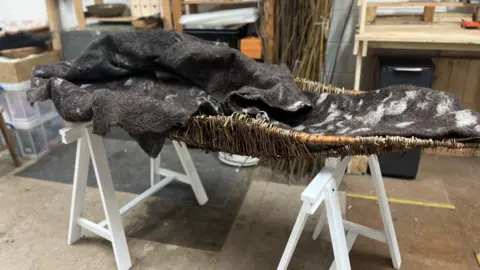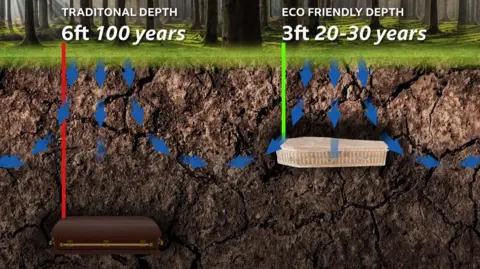‘I don’t want to be put in a box when I die – I want an echo funeral’

 Lizzie Steele/BBC
Lizzie Steele/BBC“I don’t want my last job on this planet to be a polluting job if I can help it,” explains Rachel Hawthorne.
She is preparing to make her own burial shroud because she is concerned about the environmental impact of traditional burial and cremation.
She adds, “I try very hard to recycle and use less and live an eco-friendly way in my life, so I want my death to be like that.”
Gas cremation produces carbon dioxide emissions estimated to be equivalent to a return flight from London to Paris and around 80% of those who die in the UK are cremated each year. a report From carbon consultancy firm, Planet Mark.
But traditional funerals can also be polluted. Non-biodegradable coffins are often made from harmful chemicals and bodies are embalmed using formaldehyde: a toxic substance that can leach into soil.
 Lizzie Steele/BBC
Lizzie Steele/BBCone in recent survey From Co-op Funeralcare, conducted by YouGov, one in 10 people said they wanted a more ‘eco-friendly’ funeral.
Rachel, from Hebden Bridge, West Yorkshire, made a burial shroud for a friend from locally sourced wool, willow, bramble and ivy, as part of her work as an artist.
Over the years she has explored themes of death, dying, grief and nature through crafts and functional objects.
But the 50-year-old woman sees the shroud, which could also remove the need for a coffin, as more than just a work of art – and has since decided to make it herself.
A common reaction from people who have seen the creation is to ask if they can touch it, to feel how soft it is.
For Rachel, it’s the perfect way to help people address the taboo subject of death.
She also works as a death doula, which involves assisting dying people as well as their loved ones in making informed funeral care choices.
She says, “I think when we talk about death, everyone I’ve met finds it a useful and healthy thing, and something that enriches life.”
“When someone dies it is often very shocking. We’re just on the treadmill of ‘it just happens,’ so I want to open up those conversations.
“I want more people to know that options exist and that we don’t have to be boxed in.”
The practice of digging graves to a depth of 6 feet (1.82 m) dates back to at least the 16th century and is thought to have been done as a precaution against plague.
When Rachel’s time comes, she wants to be buried the natural way, which means using a biodegradable coffin or shroud in a shallow grave. The upper layers of soil contain more active microorganisms, so bodies can decompose in about 20 to 30 years instead of 100 in a traditional grave.

Natural cemeteries are scattered across Britain and bear little resemblance to normal cemeteries – trees and wild flowers replace man-made grave markers, and no pesticides are used.
Embalming, headstones, jewelry and plastic flowers are not permitted.

Lewis McManus’s mother was buried last year in Tarn Moor Memorial Woodland, a nature site near Skipton. The funeral included an electric hearse, a locally made woolen coffin and flowers from her garden.
“He loved nature and being outside. She was concerned about what was happening to the environment and asked for her funeral to be as sustainable as possible,” says Lewis.

Sarah Jones, a Leeds-based funeral director who organizes funerals, says the demand for stability is increasing.
Their business has expanded to four premises since opening in 2016 and the growth in permanent funerals has helped drive that expansion.
He said that from “a handful” of environmental burials, such requests now make up about 20% of his business.
“More and more people are asking about it and want to make choices that are better for the planet. They often feel that it reflects the life of the person who has died because it was important to them,” she says.
 Lizzie Steele/BBC
Lizzie Steele/BBCLike many eco-friendly industries, natural burials can cost more. Many grounds, including Tarn Moor, offer cheap plots to local people. One in Speton, North Yorkshire, is run by the community and puts profits back into the village playground.
In Tarn Moor, a plot and maintenance costs £1,177 for Skipton residents. Non-locals are charged £1,818. The nearest council cemetery charges £1,200 for a grave while the cost of a cremation here starts at £896.

The Planet Mark report suggests that often away from urban areas and transport links, travel to natural grounds for a funeral or to visit a grave can involve a greater carbon footprint than more traditional sites.
Shroud-maker Rachel recognizes these challenges but hopes for long-term change. She would like to see more local natural grounds and to normalize eco-friendly death care while respecting the choices of others.
“In times past, women would come to their marital home with their shrouds as dowry and keep them in a drawer below until they were needed,” she says.
“I don’t understand why people can’t prepare a shroud and wait for their burial.
“I think it can be normal, but everyone needs to have their own preferences about it. It doesn’t have to be a certain way.”






